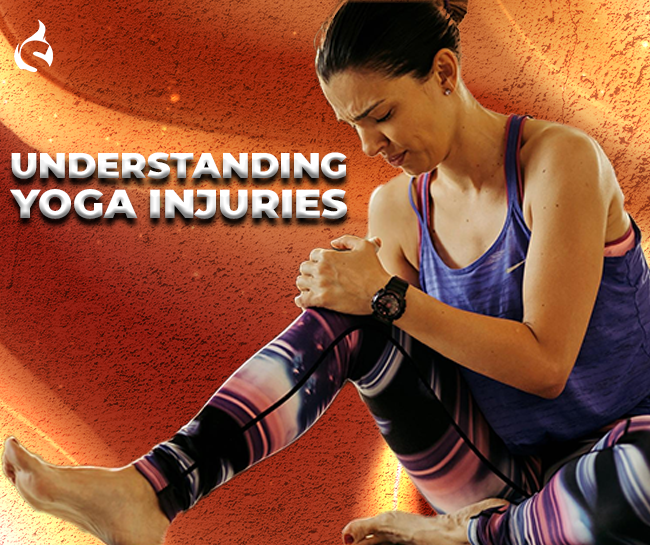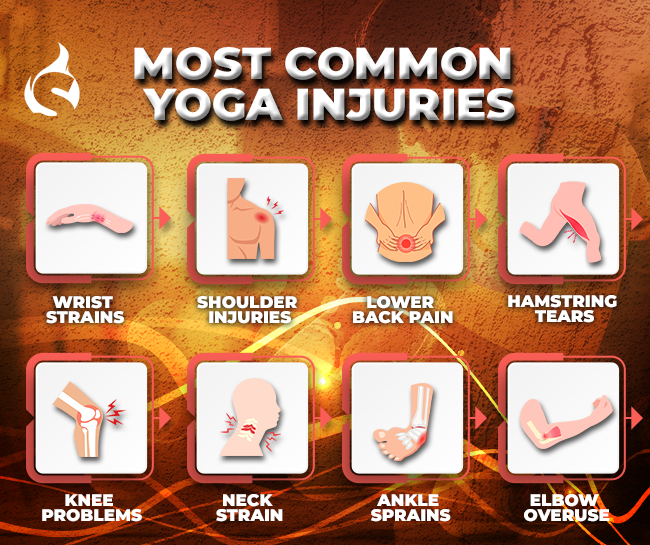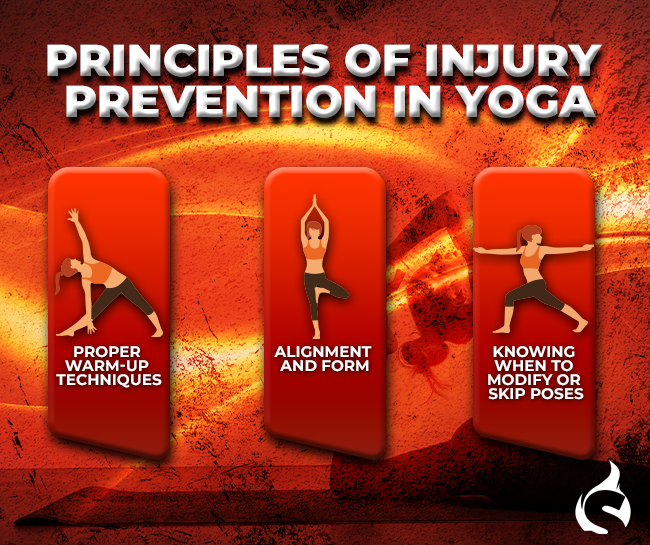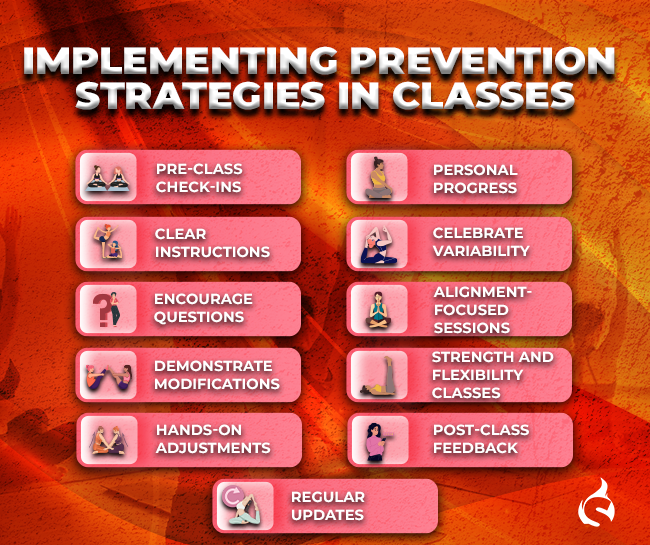
Navigating the world of yoga, where the dance between mind and body unfolds, safety takes center stage. As guides in this journey—studio owners and instructors—it’s our mission to arm ourselves with the know-how to steer clear of injuries. This guide is your go-to for weaving safety into the essence of your teachings, ensuring every student can explore their practice without fear of harm. We’ll unpack the nitty-gritty on common mishaps, dig into why they sneak up on us, and share golden nuggets on keeping our yoga space a sanctuary of wellbeing. Ready to roll out the mat on a path that keeps everyone safe, sound, and soaring in their yoga adventure? Let’s get started.
Understanding Yoga Injuries

Yoga offers a path to balance and wellness, but it’s not without its risks. Recognizing and preventing common injuries is crucial for a safe practice. Let’s dive into the most frequent injuries encountered in yoga and explore how they occur.
Most Common Yoga Injuries

Even in the calm of a yoga studio, injuries can happen when we least expect them. Here are eight common ones to watch out for:
- Wrist Strains: These occur when too much pressure is placed on the hands, especially in poses like Downward Dog or arm balances.
- Shoulder Injuries: Incorrect alignment in poses such as Chaturanga can strain the shoulders, leading to pain or injury.
- Lower Back Pain: Often a result of overexerting during forward bends and twists without proper support or engagement of the core muscles.
- Hamstring Tears: Aggressive stretching or pushing too far in poses like forward folds can lead to hamstring injuries.
- Knee Problems: Misalignment or excessive pressure in poses like Lotus or Warrior can harm the knees.
- Neck Strain: Inversions or poses that put weight on the neck, like Shoulder Stand, can lead to strain if not done with proper support and alignment.
- Ankle Sprains: Balancing poses or transitions can sometimes lead to awkward landings or twists, resulting in sprained ankles.
- Elbow Overuse: Repetitive strain from poses that require bending and supporting weight with the arms can lead to conditions like tennis elbow.
💡Understanding these risks, they can implement preventive measures, provide proper guidance, and build trust within the yoga community. This fosters a safer environment and enhances the studio’s reputation as a place that prioritizes student well-being.
Why Injuries Happen

Injuries often stem from a mix of enthusiasm and unawareness. Key factors include:
- Pushing Beyond Limits: Striving for more advanced poses without adequate preparation or flexibility.
- Ignoring Body Signals: Overriding discomfort or pain, mistaking it for a necessary part of growth.
- Improper Technique: Misalignment and misunderstanding pose goals can lead to unnecessary strain.
- Skipping Modifications: Not using props or adjustments can make poses unsafe for different body types or flexibility levels.
💡 Awareness and adaptation are the keys to a safe yoga practice. By understanding these common injuries and their causes, we can guide ourselves and our students toward a more mindful and injury-free journey on the mat.
Principles of Injury Prevention in Yoga

Creating a safe yoga practice is about more than just avoiding injury; it’s about nurturing an environment where the body can grow strong and flexible without harm. Here are the foundational principles to help keep your practice safe and enjoyable.
Proper Warm-Up Techniques
Adequate warm-up is crucial for preparing the body for the range of motions required in yoga. Dynamic stretches that mimic the movements in class can increase blood flow, enhance flexibility, and reduce the risk of strains.
Alignment and Form
Emphasizing the importance of alignment and form in each pose can prevent most yoga-related injuries. Instructors should guide students through the correct positioning and adjustments, ensuring a safe practice for all levels.
Knowing When to Modify or Skip Poses
Understanding and respecting individual limitations is key to injury prevention. Encouraging the use of props and offering modifications for complex poses can help students enjoy a fulfilling practice without risking harm.
By integrating these principles into your yoga practice and teaching, you create a supportive environment that prioritizes well-being and safety. This approach not only helps prevent injuries but also deepens the overall yoga experience, making it more enriching and sustainable for everyone involved.
Implementing Prevention Strategies in Classes

Creating a culture of safety in yoga classes goes beyond individual practices; it’s about fostering an environment where every student feels supported and secure. Here’s how to implement injury prevention strategies effectively in your classes.
- Pre-Class Check-Ins: Start by asking students about any injuries or concerns before class begins. This awareness allows you to tailor advice and modifications.
- Clear Instructions: During class, offer clear, concise instructions and explain the purpose behind each pose, focusing on how to execute them safely.
- Encourage Questions: Make it known that questions are welcome. A curious student is an engaged and safe student.
- Demonstrate Modifications: Show various modifications for poses, highlighting how they can be adjusted for different levels of flexibility or strength.
- Hands-On Adjustments: With consent, provide gentle hands-on adjustments to help students find the correct alignment and understand the intended posture.
- Personal Progress: Remind students to focus on their own progress rather than comparing themselves to others.
- Celebrate Variability: Highlight the beauty of diverse body types and abilities, reinforcing that every individual’s yoga practice is unique.
- Alignment-Focused Sessions: Dedicate classes to exploring alignment in depth for common poses, discussing how proper alignment prevents injuries.
- Strength and Flexibility Classes: Offer classes aimed at building the strength and flexibility needed to support a safe yoga practice.
- Post-Class Feedback: Encourage students to share their experiences and any discomfort they felt during class. This feedback can guide adjustments in teaching methods and class structure.
- Regular Updates: Keep students informed about the latest in yoga safety and how it applies to their practice. Share articles, studies, and tips that reinforce the importance of injury prevention.
Yoga injury prevention is not just about avoiding harm; it’s about enhancing the practice for every student. By focusing on proper warm-up, alignment, and individual capabilities, instructors can lead by example, promoting a healthier, safer yoga community. Let’s commit to ongoing education and awareness, ensuring that our classes remain spaces where everyone can explore their practice safely and confidently.
Enhance your yoga studio with Spark Membership Software – the top-tier solution for studio management. With its comprehensive features and user-friendly interface, Spark simplifies tasks and maximizes profitability. Join the vibrant community of successful yoga studios and elevate your business to new heights.




